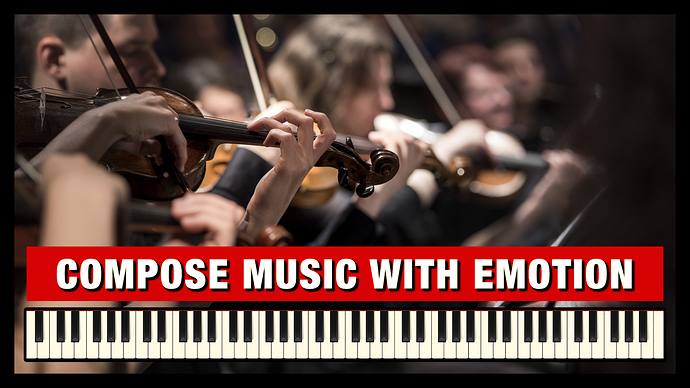Hello Composers, Mike here! 
I will now share with you, 7 tips on composing music with amazing emotion. But first I want to start with what I consider the golden rule of emotion in music:
-
HOW you play the notes is more important than WHAT notes you play
(meaning the way you play the music is what creates emotion)
Before I start, check out my MIDI Master Collection (Free Download) in case you missed it.
Now let’s dive into the 7 tips! 
Tip 1 - Use Expressive Sounds
What do I mean by expressive sounds? Well, some instruments and sounds have more expressive capabilities than others. For example: A straight saw-tooth waveform on a synth that you play as a long sustained note without modulation will sound super boring. This is because when it comes to the actual sound, emotion comes mainly from movement, variation and expression in tone color.
Some examples of instruments with great expression are bowed string instruments like violin and cello. Instruments with great dynamic range and tonal variation, such as brass, woodwinds, piano and acoustic guitar. And of course, the most expressive instrument of them all. The human voice. Either in solo, or harmony in a choir.
Tip 2 - Write Emotional Harmonies
Getting your chords and harmonies more expressive, starts with the actual harmonic progression. Use more emotional chords, which does not only have to be minor, but does have to add emotional intervals in the voice leading of your progressions. Suspended chords are for example amazing as emotional passing chords.
Tip 3 - Transition with Lyrical Legato
Variation and movement are incredibly important aspects for emotion in music. And one such element is the very transition between two notes. You can either have a gap, meaning non-legato.
Or you can use various speeds of legato transitions, all the way to a portamento or glissando between two notes. Just don’t overdo slow portamentos, just like you should not over-do any technique in music composition.
Tip 4 - Add Beautiful Vibrato
Adding movement to the sustain of the sound is great for expression and emotion. Vibrato is one of the most natural way to add emotion to a sustained note. Singers do this almost automatically without thinking about it.
Some instruments lack the ability to add vibrato to a sustained note, such as piano for example. And others are amazing for the vibrato capability, such as bowed strings for example. Remember to also add movement in the very vibrato to change how it comes in and fades out. As well as how fast and deep the vibrato goes.
Tip 5 - Record Dynamic Expression
Dynamic variation and movement is a key element of expression. There are two separate dynamic expression aspects you should record and automate.
First the initial dynamic value when a note starts. This is controlled by the MIDI velocity value in your DAW. You should have both variation overall in here, as well as a dynamic story curve to build or reduce the intensity in the performance.
The other way is to change the dynamic over time for a sustained note or chord. Which is not possible for all instruments. But orchestral instruments are great for this, such as: strings, brass and woodwinds. A bonus tip here is that silence is also a part of dynamics. So use the power of silence to your advantage when writing and recording your music.
Tip 6 - Write with Tempo Variation
Recording your parts and performance with tempo variation can bring a lot of expression to your music.
First, there is the actual sense of tempo in the performance of the instrument part. For example, starting slow and increasing the tempo in the performance. Basically creating dynamic variation in the very sense of tempo of that part, without changing the BPM of the composition.
The second way is to create tempo curves and changes in the overall composition, by changing the BPM over time in your DAWs tempo track. For example, having the chorus or power section a bit higher in BPM, the intro and perhaps a break down at a lower BPM, the verse somewhere in between…and then a gradual decrease of tempo in the final outro and cadence of your music composition.
Tip 7 - Always Focus on Emotion First
Now, this might sound obvious, but I will make this my final tip anyway. You should always focus on the emotion first in every performance your record. Take advantage of the full range of expressive performance capabilities you have at your disposal for that particular instrument.
Make every performance as expressive and emotional as you can in the very recording. And then add even more in the editing in your DAW.
Share your Tips/Tricks for Emotion in Music
I would love to hear your own tips on how you add emotion and expression in your music compositions. Write a reply below to share your thoughts and ideas! 
PS. You haven’t missed my MIDI Master Collection (Free Download) have you? =)
Sincerely,
Mikael “Mike” Baggström
Founder of professionalcomposers.com
